Perceived Knowledge of Cassava Value Chain Actors on Varietal Preferences for Various End Uses
DOI:
https://doi.org/10.14738/tnc.113.14568Keywords:
Value chain actors, Selection criteria, SWOT analysis, Desired traits, CassavaAbstract
This study assessed end users’ perceptions about preferred traits for various end uses, constraints, and varietal preferences using Participatory Rural Appraisal (PRA). A purposive sampling procedure was used to identify value chain actors. A total of 360 questionnaires were administered to 120 producers, 72 processors, 72 consumers and 96 traders. The study revealed that, 89.2% of the respondents grow cassava only whilst 82.5% grow and process in the three study districts. Farmers commonly select cassava varieties with focus on high yield, root size, root taste, early maturity period and inner color. Mean rank of studied traits were significantly (p ≤ 0.0001) differed among cassava producers and processors. In Bo district, high root yield (1st), root size (2nd), dry matter content (3rd) and starch content (4th), were the most important traits. In Bombali district, high root yield (1st), root taste (2st), dry matter content (3rd) and poundability (4th) were the most desired. In Kenema district, high root yield (1st), root taste (2st), maturity period (3rd), and poundability (4th), were the most desired. The overall ranking based on producers’ selection criteria revealed that starch content, dry matter content, root size and ease of peeling as the top key traits considered for cassava processing. Results suggest that participatory variety selection and participatory plant breeding techniques should be explored to promote collaborations between stakeholders and breeders for development of new cassava varieties with desired traits including high dry matter content, high root yield, high starch content and other desired key quality traits.
Downloads
Published
How to Cite
Issue
Section
License
Copyright (c) 2023 Kumba Yannah Karim, Prince Emmanuel Norman

This work is licensed under a Creative Commons Attribution 4.0 International License.






